
The FAA Is Almost Finished With Starship & Boca Chica’s Final PEA
One of the most exciting future launches that many of us have been waiting for has to do with Starship and Boca Chica. Over the past few months, SpaceX has continued to make impressive progress on the launch site and Starship prototypes in preparation for the first orbital test flight. However, before Starship can take flight from Texas, the launch vehicle and site itself are still awaiting approval from the FAA.
For multiple months now the Federal Aviation Administration has continued to delay the release of Starship’s Final PEA or Programmatic Environmental Assessment. This has been concerning as the company is getting very close to being ready for the launch. However, just yesterday the FAA delayed it once again, but this time only two weeks away to June 14th.
This smaller delay suggests that the FAA is genuinely close to finishing the Final PEA and will release an update in the coming weeks. SpaceX needs the approval now more than ever as final tasks are being completed such as Ship 24 being rolled out to the launch site. Here I will go more in-depth into the FAA’s process, SpaceX’s progress, and what to expect in the coming weeks regarding this important information.
Recent Two Week Delay

For months now we have seen a similar pattern from the FAA regarding Starship’s Environmental Assessment in Boca Chica. This has been a new month delay practically every month for quite a while now. Specifically, the review was originally set to be released around the end of 2021. This however, has not been the case, and the FAA rather than give a more accurate estimate for the release date, continued to delay the PEA another month. Thankfully, after around half a year of month-long delays, they just delayed it two weeks. Most recently, the FAA intended to release the Final PEA on May 31st, 2022. The FAA now plans to release the Final PEA on June 13th, 2022 to account for ongoing interagency consultations.
SpaceX proposes to conduct Starship and Super Heavy launch operations from the Boca Chica Launch Site in Cameron County, Texas. In order for this to happen, SpaceX must apply for and obtain an experimental permit(s) and/or a vehicle operator license from the FAA Office of Commercial Space Transportation to operate the Starship/Super Heavy launch vehicle. The FAA’s evaluation of a permit or license application includes a review of 1) public safety issues (such as overflight of populated areas and payload contents); 2) national security or foreign policy concerns; 3) insurance requirements for the launch operator; and 4) potential environmental impact. Right now the FAA has been working on the final part which focuses on the environmental impact. A programmatic document is a type of general, broad NEPA review from which subsequent NEPA documents can be tiered, focusing on the issues specific to the subsequent actions. The use of a programmatic environmental impact statement (EIS) or EA, and subsequent preparation of a project specific EIS or EA, is referred to as “tiering” the environmental review. The FAA has recognized that a programmatic review and tiering may be appropriate “to sequence environmental documents from the early stage of a proposed action to a subsequent stage to help focus on issues that are ripe for decision and exclude from consideration issues not yet ripe or already decided. It’s important to point out that the completion of the environmental review process does not guarantee that the FAA will issue an experimental permit or vehicle operator license to SpaceX for Starship/Super Heavy launches at the launch site. SpaceX’s license application must also meet FAA safety, risk, and financial responsibility requirements per 14 CFR Chapter III.
One of the reasons this process has taken so long according to the FAA, has to do with public involvement and reading everyone’s concerns. The FAA is using multiple methods of stakeholder engagement and public outreach to solicit comments and feedback regarding the proposal. The Administration conducted a public scoping process and is publishing this draft PEA for public review and comment. The FAA sent an email on November 23rd, 2020, to interested parties notifying them that the FAA was in the beginning stages of conducting an environmental review for SpaceX’s Starship/Super Heavy proposal. The FAA also sent an email on December 22nd, 2020, stating that the agency was holding a public scoping period to determine the scope of issues for analysis in the draft PEA. The email provided an overview of the proposed project and the indication that the FAA would be considering the preparation of a programmatic EA as well as an overview of the FAA’s overall environmental review process. The scoping comment period was open through January 22nd, 2021. After this, the FAA released the draft PEA for a 30-day public review. The FAA provided public notice of the availability of the draft PEA for public review and comment in the Federal Register and on its project website. Following the close of the public comment period, the FAA will revise the draft PEA, as appropriate, in response to comments received, and a final EA will be prepared. The final PEA will reflect the FAA’s consideration of comments and will provide responses to substantive comments. Following review of the final PEA, the FAA will either issue a Finding of No Significant Impact (FONSI), Mitigated FONSI, or issue a Notice of Intent to prepare an EIS.
The draft PEA for the Starship and Super Heavy Program was prepared by SpaceX under the supervision of the FAA. The FAA has an obligation, consistent with laws and regulations, to independently evaluate and to take responsibility for the contents of the PEA. Subsequent to that independent evaluation, the PEA becomes a Federal document supporting the Federal actions described in the analyses. In the PEA, SpaceX has evaluated the environmental effects of certain launch-related infrastructure and pre-launch testing; however, the FAA’s Federal action is limited to the licensing of launches and only certain pre-launch activity. By evaluating the Program, rather than only the Proposed Federal Action, the PEA represents a broad disclosure of environmental effects because it examines impacts of activities that are not part of the Federal action subject to NEPA review or special purpose law compliance. The FAA’s Proposed Action, which is the preferred alternative, is to issue one or more experimental permits and/or a vehicle operator license(s) to SpaceX that would allow SpaceX to launch, which can include landing, Starship/Super Heavy. SpaceX’s goal is to use Starship/Super Heavy for low Earth orbit, sun-synchronous orbit, geostationary transfer orbit, and interplanetary missions for cargo and humans.
Starship & Approval

This brings us back up to date with the FAA’s most recent delay of two weeks. While another delay is not ideal, the fact that for the first time in around half a year, it is shorter than a month, is a very good sign. This time it’s very possible that towards the middle of June, SpaceX will either be approved for a number of launches in Boca Chica, or not. The timing is crucial as SpaceX gets closer and closer each day to the first orbital test flight. Over the past few months, the delays have been concerning, however, SpaceX has not been ready to launch yet during this time period. This is important because it means the FAA has not singlehandedly delayed the program. This has been the case in prior months, but will change not long from now. Just a few days ago we watched SpaceX roll Ship 24 to the launch site in Boca Chica. It’s clear that some of the final preparations are underway and the long-awaited orbital test flight could happen soon. This two-week delay should be promising in the fact that it could help ensure the decision is released just before SpaceX is ready.
This being said, the decision is by no means guaranteed to support the operation in Boca Chica and allow launches from Texas. SpaceX knows this and has begun working faster than ever in Florida. Here, at Launch Complex 39A, we are watching crews work on a lot of necessary infrastructure for the massive rocket including its launch tower, stand, and other crucial pieces. This site is already approved and is expected to be the main launch option in the future. As of right now, we will have to wait. Another delay is typical from the FAA but at least it suggests an actual release in the month of June.
Conclusion
Many of us have been watching Starship and Starbase progress over the past few years. In this short time frame, SpaceX has managed to turn an empty area into an orbital launch site of the future, and a rocket idea into a reality. As the company gets closer to its first orbital test flight, many eyes shift to the FAA as we await the Final PEA. This was just recently delayed to the middle of June. While not ideal, this suggests that the administration is finally almost done, and we will have the results not long from now. We will have to wait and see how it progresses and the impact it has on the space industry.
